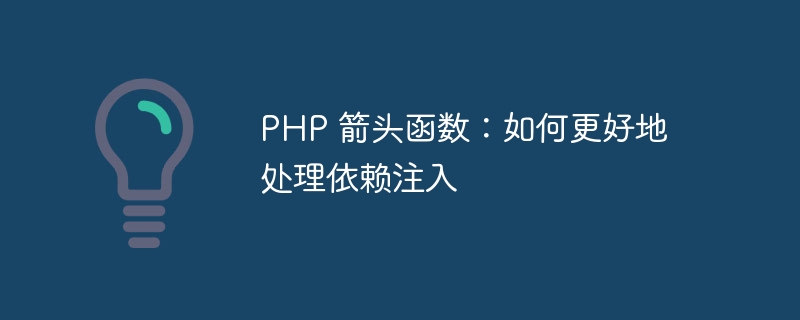

PHP Arrow Function: How to better handle dependency injection, specific code examples are needed
Introduction:
Dependency injection is a common programming concept, in oriented It is very important in the development of objects. It allows the dependencies between objects to be decoupled from the code, improving the maintainability and testability of the code. In PHP, Arrow Functions (Arrow Functions) is a new feature introduced in PHP version 7.4. It provides a concise syntax to define anonymous functions. This article will introduce how to use arrow functions to better handle dependency injection, and give specific code examples.
1. What is dependency injection?
Dependency Injection (DI) is a design pattern used to decouple dependencies between objects from the code. Its core idea is to pass object dependencies from the caller to the callee, rather than directly creating dependent objects within the callee. Through dependency injection, we can more flexibly replace the implementation of dependencies and improve the maintainability and testability of the code.
2. The syntax of arrow function
The arrow function is a new feature introduced in PHP version 7.4. It provides a concise syntax to define anonymous functions. Arrow functions use the arrow symbol (=>) to indicate the function body and omit the keyword function, parentheses in the parameter list, and curly braces. The following is the basic syntax of arrow functions:
fn (parameter list) => expression
3. Advantages of using arrow functions to handle dependency injection
4. Specific code examples of dependency injection
Suppose we have a database connection class DbConnection, which relies on the Config class to obtain the database connection configuration. Let's take a look at the traditional dependency injection method first:
class DbConnection {
private $config;
public function __construct(Config $config) {
$this->config = $config;
}
public function connect() {
$host = $this->config->get('db_host');
$port = $this->config->get('db_port');
// 连接数据库...
}
}In the traditional dependency injection method, we manually inject instances of the Config class in the constructor. Using arrow functions, we can handle dependency injection more concisely:
class DbConnection {
private $config;
public function __construct(private Config $config) {}
public function connect() {
$host = $this->config->get('db_host');
$port = $this->config->get('db_port');
// 连接数据库...
}
}By using arrow functions, we can directly use the private modifier in the constructor to define dependent objects, and omit the process of manual injection. .
In addition to using arrow functions in the constructor to handle dependency injection, we can also use arrow functions inside other methods. For example, we use the UserController class to handle user-related logic:
class UserController {
public function getById(int $id) {
$user = $this->getUserById($id);
$transformer = fn (User $user) => [
'id' => $user->getId(),
'name' => $user->getName(),
'email' => $user->getEmail(),
];
return $transformer($user);
}
private function getUserById(int $id): User {
// 从数据库获取用户...
}
}In this example, we use the arrow function to define an anonymous function $transformer to convert the User object into user information in the form of an array. By using arrow functions, we can define the transformation logic more clearly and directly call the $transformer function to complete the transformation operation.
Summary:
Dependency injection is an important design pattern that can improve the maintainability and testability of the code. In PHP, arrow functions are a concise syntax that can better handle dependency injection. This article introduces the syntax and usage of arrow functions, and gives specific code examples. By using arrow functions properly, we can simplify the dependency injection process and improve the readability and maintainability of the code.
The above is the detailed content of PHP Arrow Functions: How to Better Handle Dependency Injection. For more information, please follow other related articles on the PHP Chinese website!
 What's going on when the ip address is unavailable?
What's going on when the ip address is unavailable?
 How to learn go language from 0 basics
How to learn go language from 0 basics
 cad2012 serial number and key
cad2012 serial number and key
 The difference between currentregion and usedrange
The difference between currentregion and usedrange
 What is the difference between a demo machine and a real machine?
What is the difference between a demo machine and a real machine?
 What software is premiere
What software is premiere
 mom.exe initialization error
mom.exe initialization error
 What is the space code in html
What is the space code in html




